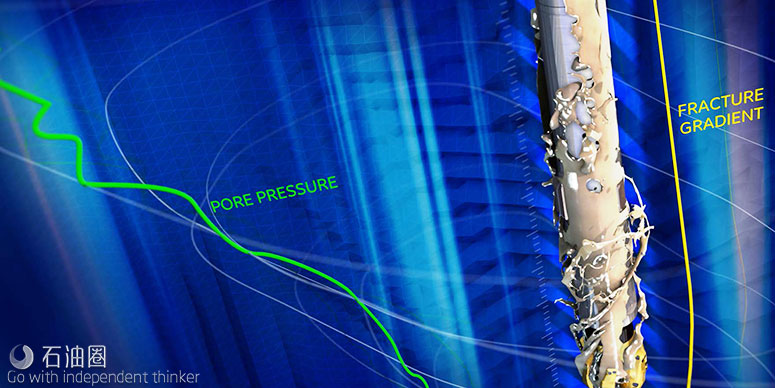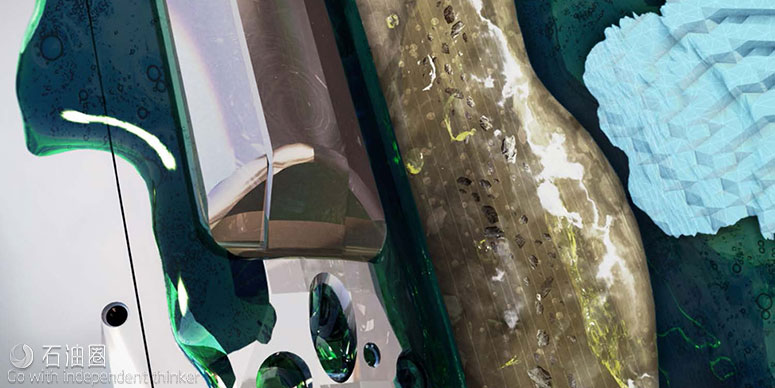In challenging offshore wells, pore pressure, fracture gradient, and complex geometry can create a narrow operating window. This can cause many problems, such as excessive surge pressures, pressure spikes due to pump initiation pressures, complicated circulation management, and the inability to control drilling parameters, which can result in catastropic events.
The typical solution to drilling in narrow windows has been utilizing a low equivalent circulating density (ECD) drilling fluid. These fluids can mitigate some risks, but not enough risks to meet drilling objectives.
The DELTA-TEQ™ low-pressure-impact drilling fluid is the only solution designed to extend the critical drilling window.
DELTA-TEQ optimizes hole cleaning using proprietary technology to control viscosity at different depths. It also avoids sag by keeping solids suspended even when pumps are off. In addition, DELTA-TEQ prevents pressure spikes at startup and surge pressure during casing runs to avoid fractures and mud losses.
As part of its innovative technology, DELTA-TEQ low-pressure-impact drilling fluid uses a mixture of specialized clay and polymers to create a non-progressive gel structure that reduces hydraulic impact. These “rapid-set/easy-break” gels set quickly when circulation stops to enable suspension of cuttings. When circulation resumes—or during casing runs—the gels break easily at lower pressure, protecting formations and reducing mud loss risk.
Furthermore, the DELTA-TEQ low-pressure-impact drilling fluid provides flexibility.
Drillers can stay in the drilling window longer by optimizing low-shear-rate viscosity (LSRV) while limiting the impact to high-shear-rate viscosity (HSRV).
Optimizing LSRV improves hole cleaning without generating excessive pressures in the circulating system. This allows for optimal rates of penetration (ROP). Minimizing the HSRV maximizes flow rates in the annulus to carry cuttings and improve ECD. This unique feature—the ability to engage viscosity at low shear rates and disengage it at high shear rates—is called the “viscosity clutch.” It was created by BHGE engineers and is unique in the industry. Shift to a low-ECD fluid that reliably performs in the clutch.
Applications
• Offshore drilling
• Narrow windows
• Highly deviated wells with known risk of barite sag
• High mud weight intervals where thin rheology is required
Benefits
• Provides effective and reliable navigation through narrow pressure windows
• Reduces well construction risks and costs
• Improves hole cleaning, flow rate, and ROP
• Manages hydraulic impact by maintaining the right viscosity in the right areas of the well
• Protects the formation against pressure spikes and surge pressure
• Remains sag-resistant and suspends cuttings during operational pauses
DELTA-TEQ low-pressure-impact drilling fluid met drilling objectives in challenging deviated well
A development project in the Gulf of Mexico was restricted to a casing program which isolated trouble zones and mitigated any risks associated with a tight drilling window. Recent projects in the area had added additional sections to isolate lost circulation zones and deployed a water-based mud system that would facilitate the treatment of losses in the trouble zones.
The project was limited by the rig’s drilling capabilities for large-hole, deep-shelf wells. The 17 ½-in. section had a maximum inclination of 65.96°, and the maximum pump rate of the rig was less than what was required to clean the hole. The inclination of the wellbore and the limited flow naturally promoted cuttings beds to form. The operator was seeking new technology that would allow for alternative wellbore geometries to expand their drilling capabilities.
Baker Hughes, a GE company (BHGE), recommended the DELTA-TEQ™low-pressure-impact drilling fluid to reduce the equivalent circulating density (ECD) and allow a higher maximum flow rate while imparting minimal pressure on the formation. In addition, the fluid would provide better assistance with hole cleaning and suspension capacity required to clean a large deviated borehole at a 66° inclination.
The DELTA-TEQ low-pressure-impact drilling fluid is a non-aqueous, advanced formulation of specialized clay and polymers that creates a non-progressive gel structure, reducing hydraulic impact with a rapid-set/easy-break profile. This profile maintains fluid integrity if operations are paused, mitigates pressure spikes when circulation resumes, and protects the formation from surge pressures when running casing.
In addition, the DELTA-TEQ fluid has the unique ability to manage hydraulic impact by maintaining the right viscosity in the right areas of the well for optimal hole cleaning and penetration rates without putting excess pressure on the formation. Like a “viscosity clutch,” it engages viscosity at low shear rates and disengages at high shear rates for true optimization.
The DELTA-TEQ fluid reduced pump pressures, allowing higher flow rates to be achieved. Additional drilling practices, such as weighted sweeps and wiper trips, ensured a clean wellbore prior to a casing run. The average difference between ECD and equivalent static density (ESD) was 0.17 ppg, despite having a deficiency of 50% on the minimum flow rate required for hole cleaning. Used in three sections of the well, the DELTA-TEQ fluid was drilled at more than 18,000 ft (5,486 m) and demonstrated a high tolerance to drill solids without major effects on rheology.
The maximum low gravity solids (LGS) concentration reached was 14% by volume and an average of 11% LGS was maintained during the entire well. Although the high amount of solids and low oil-to-water ratio was at 70:30, the DELTA-TEQ low-pressure-impact drilling fluid was able to maintain a constant rheology performance, minimizing the effect on pump pressure at mud densities ranging from 9.7 to 13.3 lb/gal. This well could not have been drilled and the casing program could not have been executed without the DELTA-TEQ low-pressure-impact drilling fluid mitigating the hole cleaning issues and flow rate limitations of the rig.
Challenges
• Deviated borehole with complicated inclination
• Limited pumping capacity
• Limited drilling capability for large holes
• Formation of cuttings beds
Results
• Maximized flow rates
• Reduced pump pressures
• Achieved high tolerance to drill solids without major impacts on rheology
• Maintained low gravity solids at 11%
• Achieved drilling depth of 18,000 ft (5,486 m)

 石油圈
石油圈

